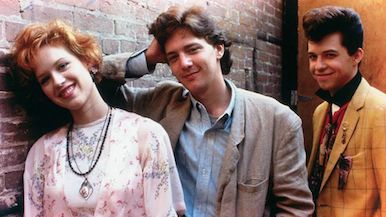The Number One Movie in America: Pretty in Pink
By Sean Collier
February 4, 2021
BoxOfficeProphets.com

This is in spite of the fact that they were not his most successful films. Even in their era, they lagged behind nearly every other film John Hughes was involved in.
“Pretty in Pink,” for example, is as an iconic slice of Hughes’ teen stories as any. It made an unspectacular $40.4 million during its theatrical run, finishing outside that year’s box-office Top 20. Among those that beat it: Hughes’ own “Ferris Bueller’s Day Off,” a more broadly targeted comedy that netted more than $70 million.
Elsewhere in Shermer, Illinois, the fictional setting for Hughes’ teen flicks, “The Breakfast Club” made $45.8 million, “Weird Science” netted $23.8 million and “Sixteen Candles” pulled in $23.6 million. Those numbers aren’t embarrassing for the mid-’80s, but Hughes’ filmography is littered with bigger hits in the same era. Each of the three “Vacation” movies made that decade earned more. “Planes, Trains & Automobiles” earned more. “Uncle Buck” made more.
Hughes pivoted to family entertainment in 1990 with “Home Alone” — which nearly tripled the combined box-office take of the four Shermer, Illinois pictures.
While the teen box office market would explode a decade later, targeting films squarely at that demographic was not quite a recipe for success in the mid-’80s. Yes, teens at the new multiplexes may have shelled out a few bucks (because that’s all tickets cost at the time) to see Molly Ringwald, but they were just as likely to see an “Indiana Jones” caper or an R-rated comedy — and, unlike “Pretty in Pink,” those other films targeted more than just the teen set.
It may also be the case that Hughes’ pictures didn’t resonate unless you could directly relate to them. Anyone who watched “Pretty in Pink” or “The Breakfast Club” as a teenager likely has a deep, abiding connection with one character or another. Find someone who checked back on these films as a grown-up and you’ll get a different reaction — and often not a very favorable one.
In the case of “Pretty in Pink,” that may take the form of a rejection of the film’s central love triangle. Andie (Ringwald), a scholarship student at an elite high school, is forever marked by her financial status in the eyes of her classmates. A fellow kid from the wrong side of the tracks, Duckie (Jon Cryer), has been after her affections for years; meanwhile, she’s enamored with rich kid Blane (Andrew McCarthy).
If you were a teen girl when you watched this for the first time, you likely have a strong opinion on which of the two Andie was meant to end up with. If not, you’re much more likely to recognize that both of them are awful; Duckie is a condescending, territorial clinger who stalks Andie, while Blane truly can’t get over his class concerns and embarrassment at Andie’s circumstances. Some romance: The best choice would’ve been to bail on the whole situation and wait for college.
That’s a modern perspective, I suppose, and one without being able to relate to the character. In the ’80s, plenty of teens did (and, I’ll admit, I found “Breakfast Club” very relevant when I watched it as a 17-year-old). The fond memories of “Pretty in Pink” were genuinely earned.
There are just fewer of them than you’d think, if the box office is any measure.
“Pretty in Pink” is the subject of the latest episode of The Number One Movie in America, a look back at past box-office champions. Each episode’s film is drawn at random from a list of every number-one movie since 1977. Please listen and subscribe!
Next time: No, not the TV show. Not the movie you remember, either. There was a sequel. Really, there was! It was a hit and everything!